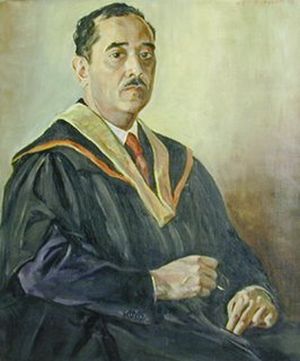
by James Porter, 1923
James Vernon Herring was an influential American artist and teacher in the early twentieth century. He played an integral role in devising new ways by which art would be viewed from both academic and commercial standpoints. He was also an important figure in the promotion of works of little known African American artists.
A native of Clio, South Carolina, James Herring studied at Syracuse, Columbia, and Harvard Universities. Upon graduation from Harvard, he became an instructor at Howard University in Washington, D.C. in 1921. One year later he founded the Art Department and served as mentor to artists/art historians James A. Porter and David C. Driskell. In 1930, Herring organized the art gallery at Howard, a first of its kind in two regards: it was the only gallery on a historically black university campus (HBCU) and it was the gallery to be directed and controlled by African Americans. While curating the gallery, Herring also served as chair of the Howard University’s art department for 21 years.
Herring, the artist, was trained in the tradition that artistic renderings should be relatively realistic. He was, however, also was capable of embracing newer artistic trends and was particularly influenced by French Impressionism. Although first introduced in Paris in the 1870s, by the early twentieth century Impressionism was rapidly gaining popularity among U.S. artists, art critics, and art consumers.
Herring’s own works reflect that change. His Campus Landscape (1922) employed a gentle Impressionist lighting technique as he portrayed university students near the reservoir at the Howard University campus. Another example was his Newport Scene, painted sometime in the 1920s. This work was an image of sailboats against the coastline in the distance under hazy light and reflection evocative of French Impressionism.
In 1943, Herring, along with Alonzo J. Aden, a former student and colleague, opened the Barnett-Aden Gallery in their home in Washington, D.C. Alhough the gallery’s prime focus was to collect and display African American art, it also collected works by non-black artists to emphasize the need to integrate the public presentation of art without the barrier of race. The Barnett-Aden Gallery became the first gallery to display the works of contemporary white and black artists side-by-side, emphasizing their artistic similarities rather than their racial differences.
The Barnett-Aden Gallery became an incredibly important resource to black artists because it gave them a platform from which various audiences from a variety of backgrounds could view and discuss their work. Besides integrating the work of black and white artists, the gallery purposely presented the works of relatively unknown painters alongside those of established, prominent artists.
The Gallery soon became the most prominent meeting place in Washington, D.C. for individuals of all walks of life to congregate. Writers, musicians, other artists, art patrons and public figures of all races mingled and interacted at the gallery at a time when Washington was still an otherwise racially segregated city. The choice to have the gallery in a private residence also lent a sense of intimacy usually missing from more formal and impersonal galleries.
James V. Herring managed the Barnett-Aden Gallery for 25 years until his passing in 1969.


